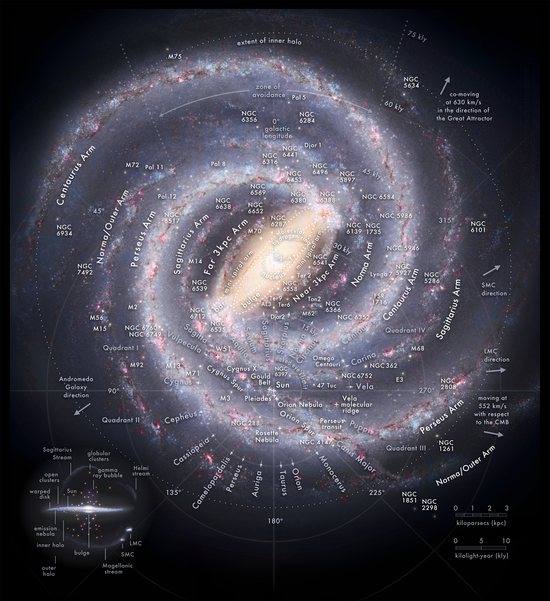Overview of the Milky Way Galaxy
The Milky Way Galaxy is the celestial home of our solar system and is one of billions of galaxies in the observable universe. Here's an overview of its key characteristics:
1. **Structure**: The Milky Way is a barred spiral galaxy, meaning it has a central bar-shaped structure surrounded by spiral arms. It is estimated to have a diameter of about 100,000 to 120,000 light-years.
2. **Components**: The Milky Way consists of several main components:
- **Galactic Center**: At the core of the Milky Way lies a dense region known as the galactic bulge, which contains a supermassive black hole called Sagittarius A*.
- **Spiral Arms**: Spiral arms extend outward from the galactic center, containing a mix of stars, gas, and dust. Our solar system is located within one of these spiral arms, known as the Orion Arm or Local Spur.
- **Disk**: The disk of the Milky Way contains most of its stars, gas, and dust, organized into a flattened, rotating structure. The disk also includes the spiral arms.
- **Halo**: Surrounding the disk is a spherical region called the halo, which contains older stars, globular clusters, and dark matter.
3. **Stars**: The Milky Way is home to an estimated 100 to 400 billion stars, including our own Sun. These stars vary in size, temperature, and age, with some being much larger and hotter than the Sun, while others are smaller and cooler.
4. **Gas and Dust**: Interstellar gas and dust are scattered throughout the Milky Way, primarily in the spiral arms. This material serves as the raw material for star formation and contributes to the galaxy's overall structure and dynamics.
5. **Galactic Rotation**: The Milky Way rotates around its center, with different parts of the galaxy moving at different speeds. It takes our solar system approximately 225 to 250 million years to complete one orbit around the galactic center, known as a galactic year.
6. **Neighborhood**: The Milky Way is part of a group of galaxies known as the Local Group, which also includes the Andromeda Galaxy (M31), the Triangulum Galaxy (M33), and dozens of smaller galaxies. The Local Group, in turn, is part of the larger Virgo Supercluster.
7. **Observation**: Observing the Milky Way from Earth's vantage point, we see it as a luminous band of stars stretching across the night sky, particularly visible in areas with minimal light pollution. The Milky Way's appearance varies depending on the observer's location and time of year.
The Milky Way Galaxy is a vast collection of stars, gas, dust, and dark matter, forming a spiral-shaped structure that stretches across space. Here are some key points about our galaxy:
1. **Size and Shape**: The Milky Way is a barred spiral galaxy, with a central bar-shaped structure surrounded by spiral arms. It has a diameter of about 100,000 to 120,000 light-years and is estimated to contain between 100 to 400 billion stars.
2. **Components**:
- **Galactic Center**: At the core of the Milky Way lies a dense region called the galactic bulge, which contains a supermassive black hole known as Sagittarius A*.
- **Spiral Arms**: The Milky Way has several spiral arms, including the Perseus Arm, the Scutum-Centaurus Arm, and the Orion Arm (where our solar system is located).
- **Disk**: Most of the Milky Way's stars, gas, and dust are concentrated in a flat, rotating disk. The disk is where active star formation occurs and where the spiral arms are most prominent.
- **Halo**: Surrounding the disk is a spherical region called the halo, which contains older stars, globular clusters, and dark matter.
3. **Stars and Stellar Populations**: The Milky Way contains stars of various ages, sizes, and compositions. It has a population of older stars found in the halo and bulge, as well as younger stars located in the disk and spiral arms.
4. **Gas and Dust**: Interstellar gas and dust are distributed throughout the Milky Way, primarily in the spiral arms. This material serves as the raw material for star formation and contributes to the galaxy's overall structure and dynamics.
5. **Rotation and Orbits**: The Milky Way rotates around its center, with stars, gas, and dust orbiting the galactic bulge. Our solar system orbits the galactic center at an average speed of about 828,000 kilometers per hour (514,000 miles per hour).
6. **Neighborhood**: The Milky Way is part of a small group of galaxies known as the Local Group, which also includes the Andromeda Galaxy (M31), the Triangulum Galaxy (M33), and several dozen smaller galaxies.
7. **Observation**: From Earth's perspective, the Milky Way appears as a band of light stretching across the night sky. This band is made up of millions of stars that are visible to the naked eye, particularly in areas with minimal light pollution.
The Milky Way Galaxy is a fascinating cosmic structure that continues to captivate scientists and astronomers as they explore its composition, evolution, and place in the universe.

Comments
Post a Comment